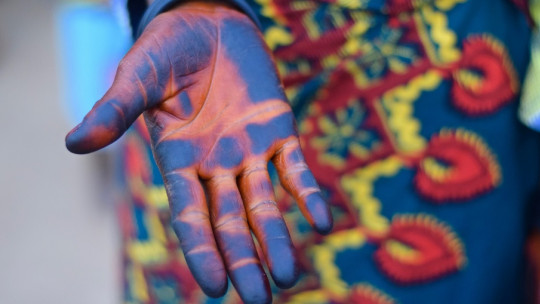
When we hear of someone who is “a gray person” or who has had “a gray day”, we are generally referring to the existence of qualities such as sadness or monotony and lack of hope. On the other hand, it also expresses a certain continuity and trajectory.
The truth is that gray is a very particular color, which has traditionally been given a very neutral symbolism despite having a certain tendency to receive bad consideration. This symbolism and its association with certain elements and vital moments has caused the color gray to have a certain effect and meaning on a psychic level. What does the color gray mean in psychology? We are going to see it throughout this article.
What does this color consist of?
Before starting to assess the symbolic and psychological meaning that is usually given to the color gray, it is appropriate to make a brief comment on what the gray in question is. First of all, it should be noted that, as with the rest of the colors, gray is nothing more than the product of the perception by our retinas of the refraction or lack thereof of certain wavelengths of light.
In the same way that happens with black or white, we are faced with an achromatic color which is not perceived by the pigments present in our cones but is captured by our rods, which more than color are dedicated to capturing luminosity or brightness. amount of light present in the medium.
Gray is perceived due to an intermediate point between the capture of light and its absence, or the blocking of the former by some object. Technically and at a chromatic level, gray would be the midpoint or the mixture between white and black although depending on the proportions it can be lighter or darker.
Due to its situation as a neutral point between both extremes, it also has the peculiarity that it is its own complementary (although it has an interesting contrast with colors such as yellow).
But… what does the color gray mean exactly?
Symbolism and psychological meaning of gray
Although it is not one of the most appreciated colors, gray has and has had throughout history an interesting symbolism for human beings largely due to its identification with elements of the same color.
It is a color whose meaning is in principle neutral but that easily becomes seen as negative, and to which psychologically we associate certain connotations (as Eva Heller shows in her psychology of color). It is mainly associated with the color of gray hair (and therefore with aging and age), ash and dust, as well as stone (not earth). Likewise, and although it is not exactly the same color, it is also linked to silver.
Most of the symbology associated with gray and the psychological effects that parts of it usually generate in us its relationship with these elements, as well as the fact of being a neutral point between black and white (an intermediate point that not only refers to the chromatic but also to the symbolic of each of them), which in turn have both positive and negative connotations. And if the color gray is especially characterized by something, it is because the color is neutrality, a neutrality that can also have favorable and aversive connotations.
From a negative perspective, as gray is associated with old age and age in addition to ash. It is generally linked to the idea of progressive loss, of the proximity of the end. In this sense it can be associated with the inescapable and cruelty, as well as the passage of time.
It is the color most associated with stone, from which life is not born (as happens in the case of the earth) but rather remains stable and immutable, in addition to transmitting a certain coldness and lack of heat. Although, as we have said, it is the color of neutrality, this can also be seen from a psychological perspective as indecision and weakness, as an inability to position oneself and even as repression (whether of one’s own or that of others) and fear.
The absence of chromaticism also makes it linked to boredom (which can facilitate), to monotony and routine, to apathy and conformity and to the lack of ambition, strength and ability to fight. To the lack of character and spontaneity, and to emptiness. Another of its meanings on a psychic level is that of concealment, given that it allows for easy camouflage, and deterioration.
In addition to the above, it is also worth commenting that the fact that it is linked to a decrease in the level of luminosity also makes it related to phenomena considered sad, such as rain, something that participates in the birth of expressions such as “gray day.” It is associated with the idea of a certain loss or reduction of something that already existed, a subtraction or diminution also valued negatively and which on a mental level is usually linked to sadness and melancholy as well as avoidance (and in fact facilitates these mental states ).
However, on the other hand, gray also has a much more positive affection and symbolism: on the one hand, its relationship with age speaks to us of experience and wisdom, of knowing how to be and sobriety (something that in turn generates a certain feeling of tranquility and certain protection). It is related to elegance and the ability to reflect.
Its neutrality, from a positive perspective, is also linked to the ability to value different points of view and to remain impartial. That said, another of its meanings is the idea of permanence, seriousness and tradition, and its resemblance to silver provides a feeling of value. It is also a color related to science and objectivity.
It is also linked to modesty and intelligence, as well as self-control, respect and tranquility, favoring communication and the search for equity in it. Generally, this type of meaning tends to occur more when gray has a more whitish and bright tone.
The use of gray in everyday life
The symbolism of gray It is not something merely ideological, but it also has an application in a wide variety of sectors.
At a marketing level it is usually used to represent stability, success and experience, something linked to the desire to project reliability and security. It must also be taken into account that it is linked to elegance and success, as well as the memory of times past. That is why it is usually used by brands with greater seniority or those that seek to represent classic values. For example, car brands or high-profile jewelry. Its connection with science also makes gray a frequent color in technology brands.
When worn on clothing it can be used as a concealment mechanism or to avoid drawing excessive attention, or to appear sober. It can also be used to enhance specific and striking elements of the wardrobe (for example generating contrast) or the image itself (such as the eyes).
In addition, when it is used in painting, its ease is usually used to combine it with other colors to provide a mix between expressiveness and restraint or to seek formal and disciplined environments. That is why it is common in the business environment, although generally seeking contrasts.








